Deep Dive: A Look at the Seiko Tuna 6159 and its Popular Variants
The Seiko Tuna diver’s series is the most popular watches that carry a nickname in the Seiko line.
The very first diver’s watch produced by Seiko was the 62MAS in 1965. Their next diver came out 2 years later in 1967, with the follow-up releasing in 1968. These first three Seiko divers were deemed excellent watches in those years, until a customer complaint arrived in their mailbox '68 changing the history of Seiko diver watches forever.
A short background into the diving scene of the time: during the late 60s and early 70s, recreational scuba diving was growing in popularity.
In those days, famous ocean conservationist and filmmaker Jacques-Yves Cousteau made scuba diving a recreational sport globally (until then mainly reserved for the military and marine research).

An influential figure in the world of diving and marine conservation.
Cousteou contributed enormously to the birth of recreational scuba diving in two ways:
- He was the co-inventor of the ‘aqualung’ in 1943 making the scuba gear affordable and easier to a wider range of people.
- He wrote bestseller books and created internationally famous films and series about the underwater world in his ocean-conservation efforts.
With these two catalysts combined, more and more adventure-seekers were jumping into the ocean waters and paddling down as deep as their bodies and equipment can take them. A new frontier for sports and leisure!
Constructive Criticism

Kure City is known for its rich maritime history. Source: mlit.go.jp
Back to our Seiko Tuna 6159 Diver watch origins, Seiko’s developers received a letter from a saturation diver from Kure City, in the Hiroshima prefecture in 1968.
*Saturation diving is a very specialized form of diving that allows divers to work in very deep waters without having to undergo long decompression.
The letter contained a detailed description of a flaw Seiko divers had concerning helium gas filtration which affected the crystals in a saturation environment.
Seiko engineers took note of the reported problem, and dedicated a team led by Ikuo Tokunaga to address this issue. Tokunaga’s team started their quest in the same year, proposing new designs from scratch instead of revising the classic Seiko diver’s form factor.
Seiko’s radical approach needed over seven years and 20 patents to come up with the popular Seiko Tuna 6159 and its multiple subsequent variants.

Diver's watches of the time used what's called a Helium Escape Valve. Source: Bob's Watches
Even though at that time, Rolex, Doxa and Omega were already working on the Helium Gas problem with saturation dives, it was Seiko’s novel approach that nailed the issue by designing something new.
Seiko came up with an unrivaled “Tuna Can” design, called after this nickname because of its shape. This Seiko diver watch with its particular ‘tuna case’ has been loved by fans for decades since its release.
Fruits of a Seven-Year Labor
The impressive features obtained with the Seiko Tuna diver’s series were the result of several global ‘firsts’ and more than 20 patents. This resulted in a reliable, airtight assembled professional diver watch with no rival.
Here are some of the most significant ‘firsts’ from the Tuna:
- the titanium monocoque case (no case back, a one-piece case)
-
the ceramic protective shroud
-
the revolutionary L shaped gasket (lug-less)
- the vented strap and many more
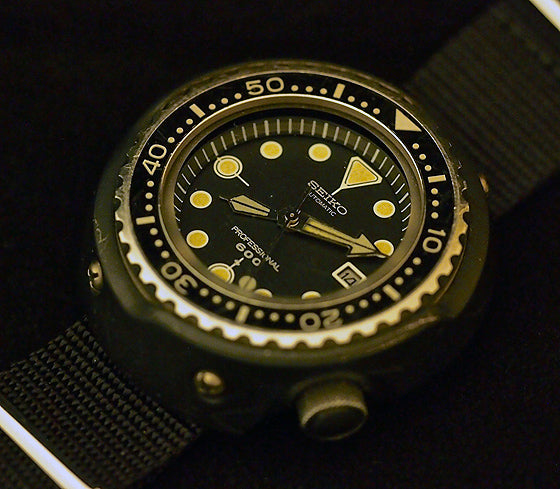
A Grandfather Tuna, yellow with time but still a sight to behold. Source: Watch Time
In 1975, the first Seiko Tuna 6159-7010 (aka. ‘Grandfather Tuna’) was released to the market to impressively withstand the requirements of professional diving.
The tuna can moniker was definitely because of its shape, being the most relevant feature of the outer case cylindrical protector. Its bulky size, diameter and thickness, and the metallic watch bezel, brings to mind the idea of a tuna can.
One of the breakthrough ideas Seiko gave to the original Seiko Tuna watch and its variants was the omission of a caseback. This one-piece case construction could only be accessed from the front, granting an airtight assembly. This allowed a solution to the helium issue by granting extreme shock resistance and immersion-proof features.

A chunky case protector allows for all-around protection. Source: Fratello Watches
Another feature is the shroud or outer case protector wrapping the side of the watch, a unique Seiko idea which became its main distinctive feature. The same way cans protect food inside, the shroud protects the watch.
The final feature worth mentioning is the vented strap, itself an exceptionally important element of product design. Engineers found a way of holding this bulky device onto the owner’s wrist in a remarkably suitable manner. This vented strap design is another example of the extraordinary talents of Tokunaga’s engineers.
Since the time that the Grandfather Seiko Tuna watch was released and thereafter, the Seiko Tuna series is deemed as a valuable diving instrument for its reliable service to professional divers.
As it was developed for the professional diving niche, its high price had no negative effect on the growing popularity of this groundbreaking product.
A quote from Mr. Tokunaga explains the accomplishments in more detail,
“… using the special gasket of L type and one-piece case became the conclusive factor in the He-tightness. As the result of the experiment, the penetration of helium gas is suppressed by about 1/100 to the conventional watch case, the inner pressure of the case does not turn into high pressure and the diver’s watch of the ideal saturation diving specification which does not need “helium gas escape valve” is completed.”
As a result of this project, since 1975 onwards, several of these Seiko Tuna diver features became industry standards.
Golden and Darth Tuna
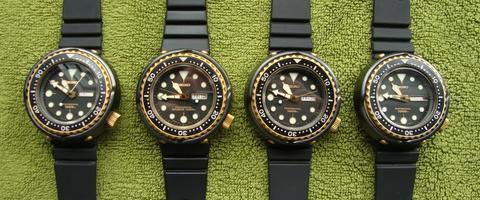
A collection of Golden Tunas. Source: The Springbar
After the initial release of the first watch in the series, the 7549A and 7C46 versions followed. Both are called “Golden Tuna” due to the distinct gold tint in their shrouds and other gold details in the dial.
The Seiko Golden Tuna went through several changes after its initial release, though styling and materials remained the same. With the Ref. SSBS018, Seiko redesigned the dial, the bezel, the vented strap and the caseback.
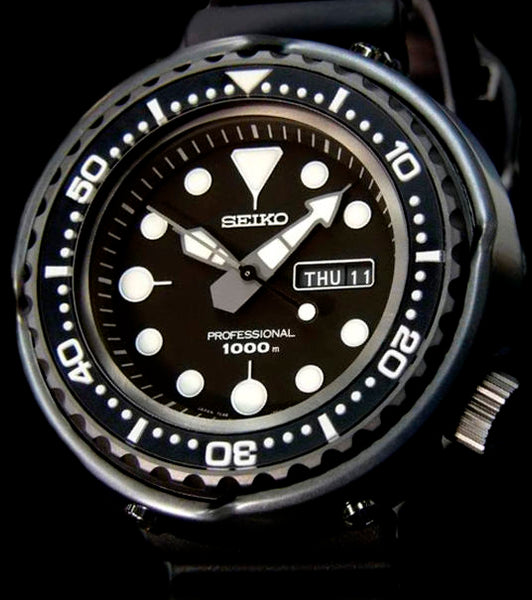
The Force not included with purchase. Source: Right Time
Later came the ref. SBBN011 – nicknamed by fans as the Seiko Darth Tuna – for its full stylistic makeover. It featured a titanium nitride coating, replacing the golden details by an all-black look (Diamond Like Coating or DLC-coated titanium).
The Star Wars-referenced watch featured the same ceramic shroud and hex screws as its predecessors, but brought a different font and a different dial.
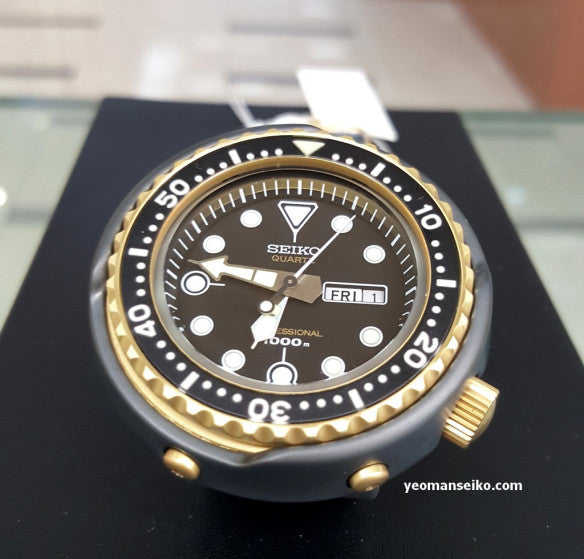
One look and you can almost instinctively tell that this watch is rare. Source: Yeoman Seiko
In 2018, Seiko issued a limited edition Golden Tuna variant that was seen as an impeccable marketing move. With only 1,978 pieces ever made, it became very valuable in the eyes of collectors.
The release was called the Seiko 1978 Quartz Saturation Diver’s Recreation Limited Edition. Quite a mouthful! Its major distinction was the new rating of 1000m of depth-in-water resistance - far deeper than most divers are capable of.
The Seiko Tuna SBDX005 Historical Collection
As a parallel product release to the Golden Tuna lineage, a little later in the year 2000, Seiko released the ref. SBDX005 to pay tribute to the first mechanical model produced in 1975 (the beloved Grandfather Tuna).
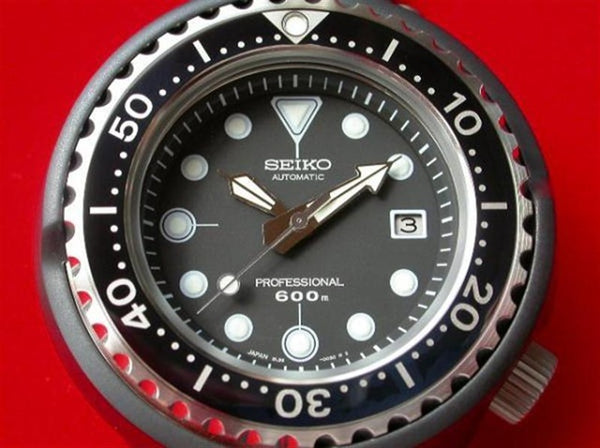
A Tuna that takes after its grandfather. Source: Quartzimodo
This Seiko SBDX005 Historical Collection resembles the iconic ref 6159-7010 in body and soul but carried the updated and excellent 8L35 movement. The reliable new movement features a 50-hour power reserve, beats at 28,800vph, and carries 26 jewels.
Seiko chose to produce a limited edition of only 1,000 units of this model.
By making the SBDX005 release a limited edition with a renewed mechanical heart, Seiko raised its price value for collectors even higher than the original watch it is based on – something that doesn’t happen very often in the watch collection world.
“Baby Tuna” Ref. 7549-7010 and 7C46-7011
From the whole Seiko Tuna series, the last movement chronologically released is the 5M23, and the watches it powered were lovingly called the “Baby Tuna’’ by Seiko fans. We can also refer to these as the 300m Seiko Tunas.
These variants are smaller and therefore more comfortable to wear for most.
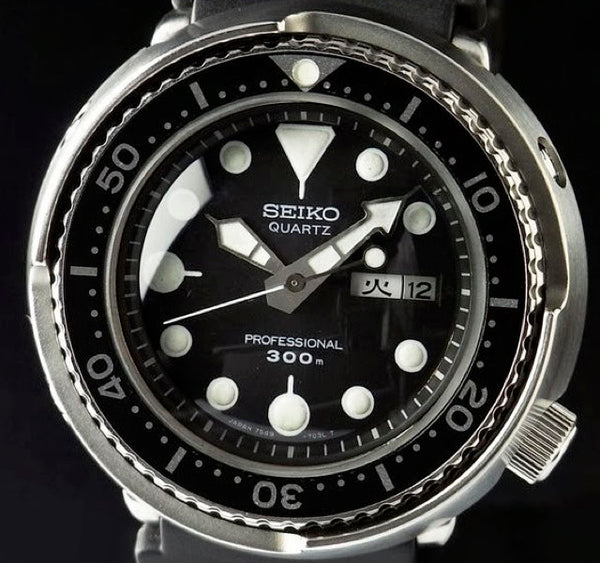
Still the same heft, but a tad more adorable! Source: Vintage-Watch
The first Seiko Baby Tuna to appear was the ref.7549-7010 released in the late 70s. The Seiko Baby Tunas recovered the lugs and the caseback as the most significant changes, and featured curved hardlex crystals.
Foregoing the monocoque case put these divers in a lower category compared to its Seiko Tuna big brothers. Nevertheless, the change made them cheaper and easier to service.
Seiko later refreshed the series with the ref 7C46-7011, becoming the Seiko diver staple in the Tuna family since the early 2000s.
Another Seiko Tuna Variant: 2021 Release
As 2021 is the 35th anniversary of the “Seiko Golden Tuna” 1000m, Seiko company released another high impact model to commemorate the occassion.
Called the Seiko Prospex 1986 Quartz Diver’s 35th Anniversary Limited Edition, this variant retains the distinctive shroud in titanium and ceramic and keeps the robust quartz movement included in the original.

That gradient dial is a very welcome choice on the Seiko Tuna. Source: Seiko Watches
However, the main design distinction of this anniversary version is the renewed dial color, with a gradient of blue on the upper half fading into black.
Meant to evoke the depths of the sea, the design of the watch removes some golden details on the original, with just the screws that secure the shroud as well as the buckle remaining golden on this anniversary edition.
We may consider this release as the top end of the whole Seiko Tuna series. It's the absolute winner in terms of construction and depth in water resistance.
This explains its price of US$2,600 at release, which although on the high side, is very cheap compared to many other big-name dive watches.
The Seiko Prospex 1986 Quartz Diver’s 35th Anniversary Limited Edition also features some design details that improves the overall look. The new blue graded in black dial goes especially well with the yellow seconds hand.
Finally, as it happens with several Tuna models, the depth level of water resistance is marked at 1000 meters, but in reality, it can perform far deeper.
Upcoming Tuna Conversion Case
If you’re a fan of the Seiko Tuna and have always wanted to make a mod of it, we have good news for you!
This July, we are releasing an SKX – Tuna conversion case: it will look like a Seiko Tuna, but it will be compatible with the vast catalogue of SKX007 parts available.
Here are the specs of the case:

The case diameter is 47mm while the lug to lug size measures 46.5mm. The strap size is 22mm. Not included in the above image is the case thickness, which comes out at 11.3mm. Overall a tad smaller from the Grandfather tuna, but a fine reproduction of the original in every other aspect.
Here are some product shots for you:

Will black and gold two-tone mods be the most popular choice for this canvas as an homage to the Golden Tunas? Or will stealth mods a-la Darth Tuna become the norm? We're excited to find out!


We are releasing more details in the coming weeks, so stay tuned to our Instagram and Facebook pages for further announcements!
The Tuna is Here to Stay!
Throughout the Seiko Tuna series’ history, the purpose-built diver watch won its spot among many ‘top 5 dive watches of all time’ lists.
Yet the passion that this Seiko Tuna lineage arouse in Seiko fans are usually radically polarized; they either love it or hate it. Surfing the internet allows one to find countless posts referring to it as an ugly watch. This might stem from a misunderstanding of the importance of certain features and its designs.
On the other hand, fans and users point out its well thought out design. Even its unique vented strap assists in a smooth fit on the diver’s wrist.
Some specific design details on your Seiko can be modified at your choice by accessing the Seiko mods catalogue to create or modify the Seiko watch you want.
At NamokiMODS you can find an incredible selection of some of the best Seiko mod parts in the world. We stock loads of parts for popular Seiko SKX 007 mods. We are also working on more Seiko inspired parts all the time, like an upcoming Tuna SKX conversion Case.
If you want to mod with some of the best Seiko mod parts in the world – please take a deep dive into our extensive catalog!

Comments
John Harmeling said:
This is my calling!
I thank you so much……..
Love, Peace and Happiness
Isaac gonzalez said:
I like to know what part do I need to complete the tuna mod including movement and glass and rest of parts to order, please thanks.